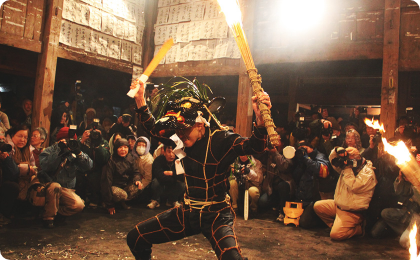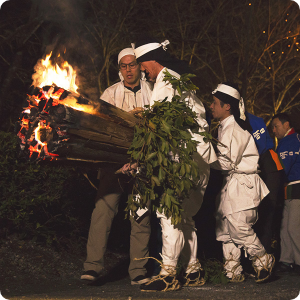

Oni※ resides in the temples of Kunisaki.
Although oni is considered frightening by many,
the oni of Kunisaki is seen as creature who brings happiness to the people.

On the night of the Shujō onie ,
it laughs, dances, and drinks harmoniously with the people.
In Kunisaki, oni and people are connected like life-long friends.

When Emperor Keiko, father of Yamato Takeru, crossed the Suo Sea to conquer Kumaso, he discovered Kunisaki, which stretched out to the east of Kyushu. For the Yamato people crossing the Seto Inland Sea, Kunisaki was a boundary with the other world and a symbol of the "farthest land. The strange mountain massifs that layered on top of one another were shrouded in fog and miasma, creating a somewhat eerie atmosphere, as if some kind of "demon" was about to appear. No, in fact, demons actually lived in Kunisaki.

On the rocky peaks radiating out from Kunisaki, a circular peninsula, one can sometimes see a gaping cave. What's more they are located in places too high for human beings to be able to step into. There, terrifying demons with tremendous power lived. In the past, Kunisaki used to be the "Daimasho," a different world where demons dwelled. There are many legends about demons in Kunisaki, such as the legend that demons used to break large rocks with their arm strength and build stone steps overnight by piling up the broken stones.

There is a night when you can meet demons in Kunisaki. This is the biggest puja in Kunisaki, the "Shusha Onikai". The demons go on a rampage with torches, sparks of fire fly, and a choking smoke fills the air. If your clothes or hair catches fire, you are in a bit of a panic, and the "Gokaji" incantation in which you are struck on the buttocks with a torch, is quite rough, but the sound of laughter is more common than screams in the temple's auditorium. This is because it is believed that a good harvest and good health will come true if one is exposed to the sparks of fire and receives blessings. Kunisaki demons are believed by the people to be good demons that use their magical powers to ward off misfortune and disasters. Many offeringsto th demons are mainly "decorative rice cakes" (kazari-mochi) and "large mirrors" (okagami). In between the long Buddhist rituals, adish called "demon's awakening" (Oni no mesamashi) with chili pepper is served to the priests, and finally, large round rice cakes "Demon eyes" (Oni no me) are scattered as a good luck charm, and people share the good fortune with each other. Every year, the "Oni-no-Mokkai" (demon's good fortune) also promises a bountiful harvest of Kunisaki's products, which should be called "Oni-no-Sachi" (the harvest of the demons).


At Iwatoji and Seibutsuji temples, the demons go out to the village after the performance in the auditorium is over. The people invite the demons to their homes, entertain them, and share sake with them. As the saying goes, "Familiar demons are better than unknown ones", and people look forward to this once-a-year night of talking with demons with great anticipation. While festivals like Setsubun, in which ogres are driven away to bring happiness, and the custom of having demons scare children into becoming good boys and girls can be found in many places, the demons of Kunisaki are in themselves a reliable bringer of happiness.


Monks are the key players in the deep friendship between demons and humans. Since ancient times, demons have been admired by Buddhist monks as beings with mysterious legal powers. Ancient Buddhist monks climbed the rocky peaks of Kunisaki in search of demons, carved out caves where demons dwelled, and created training sites called iwaya," or "rocky houses," and initiated the "Mineiri," or pilgrimage to the rocky houses. Such Buddhist culture has a thousand-year history in Kunisaki, where people naturally join hands with the gods and Buddha in sacred caves even though there are no halls or shrines. Many of the iwaya are called "Okuno-in" and are still regarded as the beginning of each temple's faith. Eventually, up to 65 temples were established in the six villages of Kunisaki, creating the Buddhist world known as "Rokugo mansan". Most of the temples in Rokugo mansan had demon masks made, and the demons played by the monks granted various wishes, from national security to praying for rain. Thus, the culture of praying to demons blossomed in Kunisaki.


Even temples that no longer hold the "Shusho Oni-kai" ceremony continue to hold offerings of Oni-kai masks on the same day as the ceremony itself. Shusho Oni-kai's masks expressions are varied and not limited to a scowling face. Sometimes they smile, sometimes they look proud, and sometimes, in spite of being demons, they may even tell you old stories about their hometown with tears in their eyes.

During the Heian period (794-1185), when esoteric Buddhism culture entered Kunisaki," "Kunisaki no Oni" came to be referred to as "Fudo Myoo". Looking at the appearance of the "Kunisaki Oni," one can see similarities with Fudo Myoo. The sword, one of the demon's possessions, is the same as Fudo Myoo's treasured sword, and Fudo Myoo's flaming halo, which burns away worldly desires, is similar to the flame of the demon's torch, which wards off misfortune. Most of Kunisaki's Fudo-myoo were once enshrined at Okuno-in, a sacred rock house where demons used to dwell. Generally, Fudo Myoo has a calm expression of anger, but in Kunisaki, there are many statues with round faces and gentle expressions. The wooden Fudo Myoo statues, such as Maki Daido and Mudoji Temple, are made using the soft expressions of the Heian period, and the stone Kumano Magaibutsu and Kawanaka Fudo statues have gentle expressions, and you will feel a deep sense of security when you stand in front of them.


And the Taroten of Chōan-ji Temple, a statue of the Kunisaki deity in the form of a child, is known from the Sanskrit characters inside to be an incarnation of Fudo Myōōō. The statue dares to represent Fudo Myoo in the form of a child with a soft face, giving it the meaning of both "god" and "Buddha," a figure that is the culmination of the wisdom of Rokugou Manzan. Through the various forms of Fudo Myoo, we can also learn the depth of the culture of praying to the demons of Kunisaki.

In Kunisaki, even scary demons become Buddhas
and grant people's wishes.
You can admire demons, meet demons,
pray to demons, and laugh with demons.









